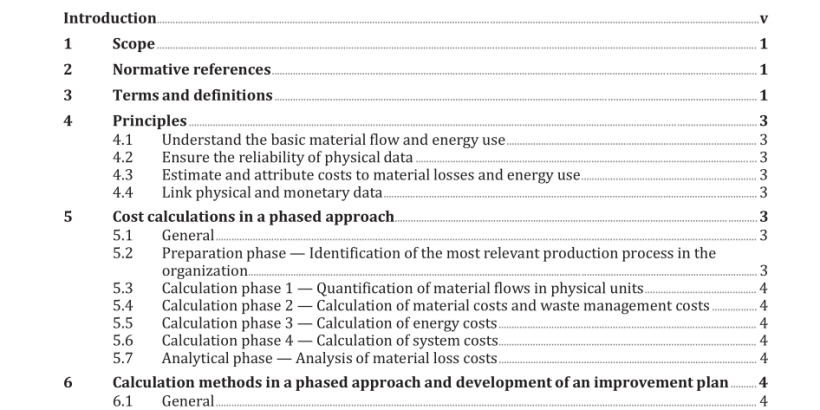ISO 14053:2021 pdf download – Environmental management — Material flow cost accounting — Guidance for phased implementation in organizations.
3.3 material substance that enters and/or leaves a process Note 1 to entry: Materials can be divided into two categories: — — materials that are intended to become part of products, e.g. raw materials, auxiliary materials, intermediate products; materials that do not become part of products, e.g. cleaning solvents and chemical catalysts, which often are referred to as operating materials. Note 2 to entry: Some types of materials can be classified into either category, depending on their use. Water is one such material. In some cases, water can become part of a product (e.g. bottled water), while in other cases it can be used as an operating material (e.g. water used in an equipment washing process). Note 3 to entry: Energy carriers like fuels or steam can be identified as materials, at the discretion of the organization. [SOURCE: ISO 14051:2011, 3.10, modified — “quantity centre” changed to “process”.] 3.4 material flow cost accounting summary sheet MFCA summary sheet spreadsheet that reflects the MFCA (3.6) information for a production process that is treated as a single process 3.5 material cost cost for a substance that enters and/or leaves a process Note 1 to entry: Material cost can be calculated in various ways, e.g. standard cost, average cost, and purchase cost. The choice between cost calculation methods is at the discretion of the organization. [SOURCE: ISO 14051:2011, 3.12, modified — “quantity centre” changed to “process”.]
4 Principles 4.1 Understand the basic material flow and energy use The material flows related to products and energy use, including material losses in the most relevant production process, are identified and quantified as physical data. 4.2 Ensure the reliability of physical data Physical data on material flows and energy use are collected in consistent measurement units. NOTE Refer to ISO 14033. 4.3 Estimate and attribute costs to material losses and energy use The costs associated with material losses and energy use are estimated, and these costs are attributed to the material losses and energy use. 4.4 Link physical and monetary data Decision-making on environmental and management issues within organizations is supported by linking physical data with associated cost.
5 Cost calculations in a phased approach 5.1 General Data on material flows and energy use should be translated into monetary units to support decision- making according to the cost calculations. This process consists of one preparation-phase, four calculation-phases and one analytical phase. Organizations can incrementally implement MFCA as indicated in 5.2 to 5.7.
5.2 Preparation phase — Identification of the most relevant production process in the organization The organization should identify its most relevant production process. If there is a single production process in the organization, all of the material losses and energy use should be examined. If multiple processes are present, the organization can select either the most relevant production process or multiple processes as one single production unit for calculation. A selection approach for the most relevant production process should be divided into two steps: a) assess the magnitude of the different material losses and energy use; b) select the process with a high raw material unit cost, large volume of material losses and defective products, etc. as the most relevant production process. If the organization wants to assess several relevant processes, adoption of ISO 14051 is recommended.
5.4 Calculation phase 2 — Calculation of material costs and waste management costs Cost calculations should be started with material costs. This includes costs related to the materials used in the most relevant production process which may include raw materials, auxiliary materials, operating materials and intermediate products. The costs of all material inputs are assigned to products and material losses according to the physical quantity. In addition, waste management costs are calculated. 5.5 Calculation phase 3 — Calculation of energy costs The calculation of energy costs is at the discretion of the organization. When it is determined to be necessary, energy costs should be calculated and allocated to products and material losses according to the physical data quantified in calculation phase 1. 5.6 Calculation phase 4 — Calculation of system costs The calculation of system costs is at the discretion of the organization. When it is determined to be necessary, system costs should be calculated and allocated to products and material losses according to the physical data quantified in calculation phase 1.
